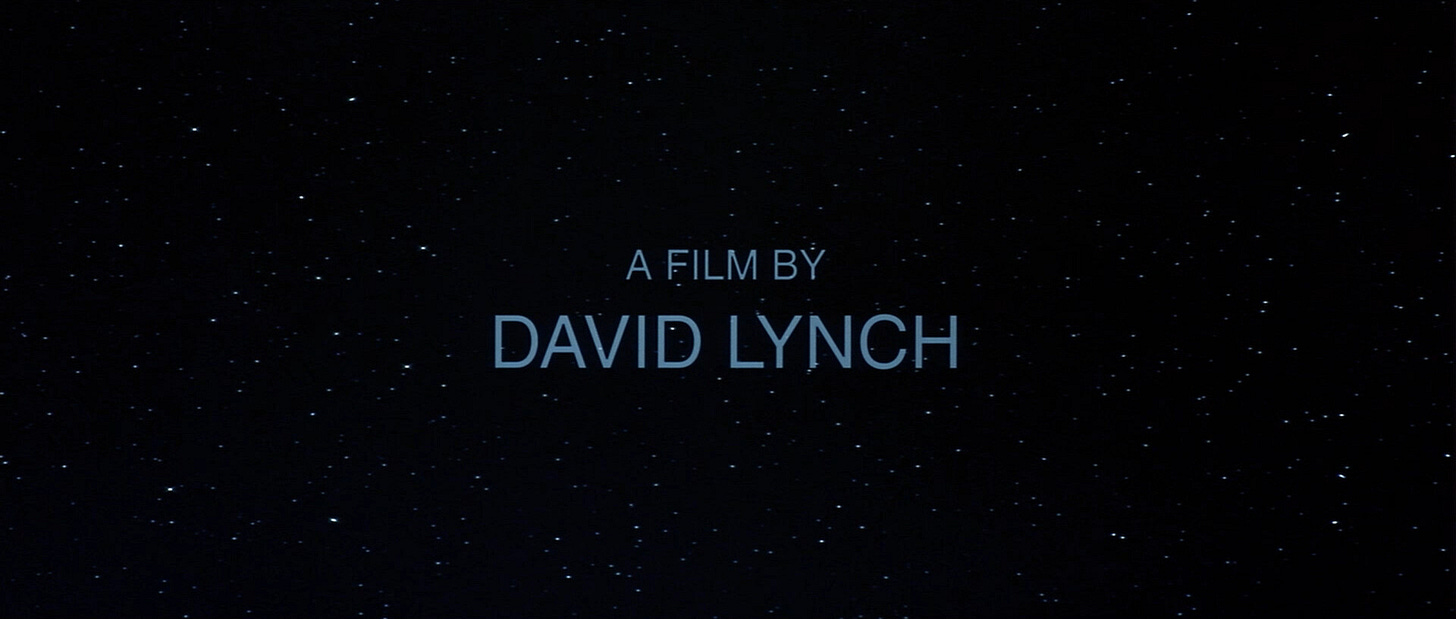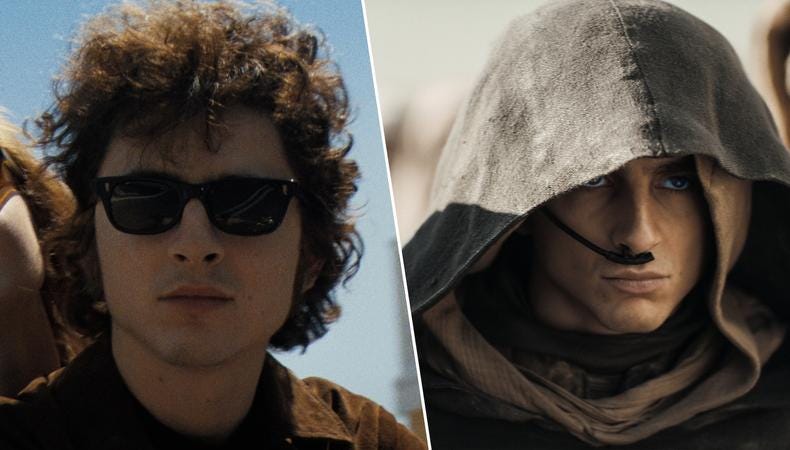David Lynch's mysteries leave room for us to get in
From 'Twin Peaks' to 'The Straight Story,' the filmmaker welcomed us to expand ourselves
Two things struck me after director David Lynch died last week. First, the blues. Second, that all the little movie weirdos on my Instagram feed felt the same way.
Despite the impenetrable mystery of Lynch’s freakiest work, it seems he spoke a universal language. He created alienating art that a lot of people came together to love. How counterintuitive; how cool!
Since everyone and their log wrote a tribute to Lynch, I stressed about the precise way to describe what his movies mean to me. I landed on words that always come after finishing one of his masterpieces:
OK, so, what?
Lynch’s most beloved movies (and TV’s “Twin Peaks”) embrace the unknown, to put it mildly. I love his weird shit because it takes me out of my own mind. Sometimes, I find terror. Other times, genuine connection.
Kyle MacLachlan, Lynch’s most recognizable leading man, just wrote a lovely tribute to his mentor for The New York Times. The mystery is the point of the director’s work, McLachlan says:
“[Lynch] was drawn to mystery because he understood mystery as a conversation — a collision of differences, interpretations, perspectives. Not a message sent down from an all-knowing source. A mystery leaves room for other people to get in there. It is two-way communication.”
It’s such an expansive way to create something. And, you know what, hell yeah. Every time I’ve interacted with a piece of Lynch, it’s opened me up to bigger thoughts, wider emotions — just more.
…
The summer after I turned 18 was real Lynch-y. I got a membership at Vulcan Video on Elizabeth Street. The store had a directors wall, which led me to “Eraserhead.” My friends and I watched Lynch’s debut feature in the clear light of day, but that movie doesn’t need a dark room to wreck your shit.
When the camera first cut to Henry’s repulsive wormbaby (spoilers, I guess), I yelped out loud. What really stuck with me, though: the Lady in the Radiator’s cheeks, all lumpy and distended, a word I learned from Googling “Eraserhead lady in radiator” after watching. I’d never in my life imagined such images. I needed more.
Back to the directors wall. Vulcan had Lynch’s web series “Rabbits.” As a person raised in captivity by Nick-at-Nite, the creepy sitcom aesthetic got me good. The titular rabbits were trapped in a static living room purgatory. Bits of unsettlingly disjointed dialogue cued a laugh track. It took something so familiar and exploded it.
The last Lynch I took from the directors wall was “Inland Empire,” a new release at the time. It’s 180 minutes long, and my friends and I probably pressed play around midnight. I remember staring into Grace Zabriskie’s unsettling eyes, and then excitement that the rabbits from “Rabbits” were in the movie. We all fell asleep at some point.
When I woke up, ladies were dancing on-screen to “The Loco-Motion.” Laura Dern was confused; I was confused. It left the kind of permanent memory you only get from a TV screen when you’re supposed to be sleeping.
Through the years, three Lynch films made me afraid to sleep at all. After watching “Twin Peaks: Fire Walk with Me,” Bob lurked at the foot of my mattress. In another apartment, the Mystery Man from “Lost Highway” stood outside my bedroom door, camcorder in his horrible, pale hand.
And I didn’t need to imagine that the alleyway ghoul from “Mulholland Drive” had invaded my space. I watched Lynch’s 2001 neo-noir on my laptop in bed as a college student. Lights off. Box of M&M cookies open. When the ghastly, ash-faced nightmare emerged from behind the dumpster, I flew like a grackle on fire. So did the cookies.
…
Lynch’s death inspired me to fill in my gaps from his filmography. “The Elephant Man” will be my last stop, since I watched “The Straight Story” on Thursday.
“The Straight Story” is quiet, life-affirming, and completely grounded in reality. No rabbits in hell, no dumpster ghouls. It’s technically about an elderly man riding a lawnmower across several states to reunite with his infirm brother. But it’s kind of really about stars in the night sky. They appear in the film’s titles. More than once, Alvin Straight (Richard Farnsworth) stops to look at them. “The sky is sure full of stars,” he tells his daughter early in the film. In fact, the whole journey to his brother is about seeing little bits of light across a big, dark expanse: “I want to sit with him, look up at the stars, like we used to do so long ago.”
“The Straight Story” follows Alvin across a literal expanse. It’s dark, figuratively. He drives miles upon miles on a piece of farm equipment. He sleeps in a little trailer and eats vacuum-sealed sausages. The rain pours down on him. He careens down a hill at one point, almost to his death.
But Lynch studs little moments of human connection along the way: the runaway teen mother who shares Alvin’s campfire, the cyclists who welcome him into their camp, the townsfolk who put him up after the near-death experience. Stars, all of ’em!
Even at his least cryptic, Lynch made me want to think bigger.
…
Amid all his mystery, one line of Lynch dialogue sounded clear to a lot of people. I confess, it’s the first thing I thought of when I heard the news of his death: “Fix your hearts or die.”
It’s a paraphrase of the actual line, from 2017’s “Twin Peaks: The Return.” Gordon Cole, played by Lynch himself, talks to his colleague Denise, a trans woman, about their history. “And when you became Denise,” Gordon says of her transition years earlier, “I told all your colleagues, those clown comics, to fix their hearts or die.”
Man. I love words.
That sentiment has especially resonated with queer people, including me, as the only thing left to say to the people who refuse to hear it. In 2017, film journal Bright Wall/Dark Room published an essay by Zach Vasquez on empathy in Lynch’s work. The “fix their hearts” line represents pure, distilled empathy — an expansion of self:
“From even a cursory study of David Lynch’s process, it seems evident that he inhabits almost full-time the imaginative spaces that he conveys through his films and his art. Those spaces—often ugly, brutal, frightful; always strange and wonderful—are large enough to encapsulate the experiences of thousands of people that he has never even met. We should all strive to discover and inhabit such spaces within ourselves, even if, especially if, the price of admission is that we must either fix our hearts, or die.”
I also quote The Giant from “Twin Peaks” a lot: “It is happening again.” When I say it, I’m usually talking about getting a large Diet Coke for the third time in a week. But Lex McMenamin wrote about the phrase’s political timelessness, for the LGBTQ outlet Them:
“Lynch’s work was sometimes inscrutable; other times, it was so blunt I found myself confused by the critics who misunderstood it. That phrase has become another totem, this one for the circular nature of homophobia and transphobia, where the people who seek to demonize us and erase us from public life are just pulling from uncreative efforts fifty years prior … Despite a lack of originality or guts, it is happening again — and in turn, a new generation of queer and trans artists is here to push back against that recurring evil.”
Speaking of circles … When Lynch’s family announced his death, they quoted from “Catching the Big Fish,” his memoir on creativity and meditation. “Keep your eye on the donut and not on the hole,” he wrote.
Not only is that top-shelf life advice, but it might be the best way I know to be a Lynch viewer. Don’t focus on what’s not there, like a solution. Focus on what is there: how it all makes you feel, or think. Get big.
One more time for the cheap seats: “A mystery leaves room for other people to get in there.”
One rad thing
Despite my attempts at omnipresence, I can’t see every movie that comes out. (Brother … I try.) So my end-of-year favorites list was bound to have a couple omissions via ignorance. Well, here’s the first one! I am now obsessed with “Flow.”
The lack of dialogue, the no-frills character designs of the animals escaping climate disaster in a little boat … you gotta see. My friend Mollie and I saw this at AFS Cinema last weekend, and we were stressed. A movie hasn’t made me feel this adjacent to cardiac arrest since “Gravity.” Filmmaker Gints Zilbalodis puts our hero, a wide-eyed black cat, in so much peril. Every 15 minutes, I was like, “Oh, cat dead” — but then cat not dead!
Don’t get me started on the capybara in this thing.
“Flow” just snagged the Golden Globe for best animated feature, and even though those awards are a grift, it’s win competitive at the Oscars. A triumph for brave lil guys everywhere!
Outbox
A fun one I did late last year for Backstage magazine: “Full Range: 11 Actors Who Played Wildly Different Roles in 2024.”
Come for my desire to see Emma Corrin play Count Orlok, stay for a scalding take on the similarity between Timothée Chalamet’s roles in “A Complete Unknown” and “Dune: Part Two”:
“Wait, are we saying it’s a subtle slide from Bob Dylan to Paul Atreides? In Chalamet’s hands, yes. And that’s not a knock on his talent—quite the opposite, in fact. He’s made a name for himself as an expressive, emotionally tuned-in performer, always letting his innate charisma shine through. His turn in James Mangold’s ‘A Complete Unknown’ requires bigger hair and a raspier voice, sure. But Dylan’s youthful intensity isn’t all that different from that of the intergalactic messiah in Denis Villeneuve’s ‘Dune: Part Two.’”
…
The New Yorker’s Michael Schulman wrote a fantastic piece about the man who better win the best actor Oscar. From “The Liberated Life of Colman Domingo,” the actor’s response to a question about later-in-life success:
“All the missteps and the things I didn’t have access to—I wouldn’t be able to do what I’m doing now if I didn’t have all that, if I didn’t have all these down times and low times and rewiring-how-I-work times. … I know how to handle this now. I know how to be affected or not to be affected by what people say, what people write. Everyone can have their opinion. That’s what they’re paid for. But I know what’s true for me.”
It’s a gleeful interview, so I shan’t spoil too much. But some teaser topics: photojournalism, Will Smith, dancing, baking, and Niecy Nash’s wedding.





